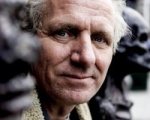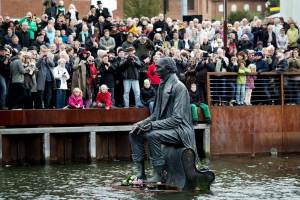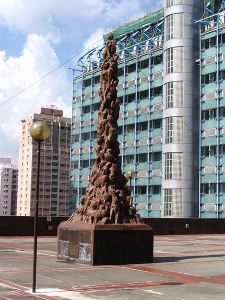Danish sculptor Jens Galschiøt is known for his social activism and works of art that provoke public discussion about human rights violations. He has just sunk a statue of Hans Christian Andersen in Odense harbour.
 In
a spat with the city authorities in Odense, Denmark, where Galschiøt
(left) has a huge foundry, studio, gallery and sculpture park, he
decided to submerge his famous statue of Hans Christian Andersen, with
plans to raise it again each year to mark the author’s birthday. The
bronze sculpture of the world’s best known writer of fairytales has sat
in Odense town square for the last five years. According to Galschiøt,
the city authorities had been planning to move it and make it part of a
larger installation in the centre of Odense, but they ran out of money.
In
a spat with the city authorities in Odense, Denmark, where Galschiøt
(left) has a huge foundry, studio, gallery and sculpture park, he
decided to submerge his famous statue of Hans Christian Andersen, with
plans to raise it again each year to mark the author’s birthday. The
bronze sculpture of the world’s best known writer of fairytales has sat
in Odense town square for the last five years. According to Galschiøt,
the city authorities had been planning to move it and make it part of a
larger installation in the centre of Odense, but they ran out of money.
“At one point the culture department talked about placing the sculpture by Odense harbour in order to attract tourists to the area. Now that the installation project is suspended, I think I will comply with their wish – maybe not in the way they expected but, on the other hand, it won’t cost them anything,” said Galschiøt.
 Before
the ceremony took place on 8 October 2011, Galschiøt reflected that
Andersen might not have approved of being submerged. “To be honest I
don’t think he would like it since he didn’t care much for events,
although he did like bathing a lot, so maybe he wouldn’t be that
unhappy,” he said. “But it would allow him to keep an eye on the
mermaids.” A statue of Andersen’s Little Mermaid – created by sculptor
Edvard Eriksen and unveiled in 1913 – adorns a rock in Copenhagen
harbour.
Before
the ceremony took place on 8 October 2011, Galschiøt reflected that
Andersen might not have approved of being submerged. “To be honest I
don’t think he would like it since he didn’t care much for events,
although he did like bathing a lot, so maybe he wouldn’t be that
unhappy,” he said. “But it would allow him to keep an eye on the
mermaids.” A statue of Andersen’s Little Mermaid – created by sculptor
Edvard Eriksen and unveiled in 1913 – adorns a rock in Copenhagen
harbour.
Since 1996 an annual award has been given to people who have contributed to promoting the storyteller’s works. Galschiøt makes a copper casting of Andersen’s book The Adventures of my Life engraved with one of his poems and the name of the prizewinner. Past recipients have included German writer Günter Grass, American film producer Steven Spielberg and Denmark’s Queen Margrethe II.
 Galschiøt
is known for creating the Pillar of Shame, the first of which was
erected in Hong Kong on 4 June 1997 just before the colony was handed
back to China and as a reminder of its crackdown on the 1989 Tiananmen
Square protests. The Pillar of Shame is eight metres high and depicts
twisted human bodies. In 2008 it was painted orange by Chinese democracy
activists as part of a worldwide Colour Orange campaign launched by
Galschiøt to denounce China’s human rights violations. The action
coincided with the Beijing Olympic Games. Galschiøt later erected more
versions of the Pillar of Shame in other cities around the world.
Galschiøt
is known for creating the Pillar of Shame, the first of which was
erected in Hong Kong on 4 June 1997 just before the colony was handed
back to China and as a reminder of its crackdown on the 1989 Tiananmen
Square protests. The Pillar of Shame is eight metres high and depicts
twisted human bodies. In 2008 it was painted orange by Chinese democracy
activists as part of a worldwide Colour Orange campaign launched by
Galschiøt to denounce China’s human rights violations. The action
coincided with the Beijing Olympic Games. Galschiøt later erected more
versions of the Pillar of Shame in other cities around the world.
Most recently, Galschiøt began an art project called SevenMeters, whose purpose is to highlight the problems caused by climate change by focusing on its human victims – climate refugees. In Copenhagen a line of blinking red lights powered by solar cells has been placed seven meters above sea-level to help people visualise the impending catastrophe if all the ice in Greenland were to melt.
Many of Hans Christian Andersen’s children’s stories such as “The Snow Queen”, “The Little Match Girl”, “The Ugly Duckling”, and “The Emperor’s New Clothes”, tackled themes of injustice. Andersen has a co-conspirator in Jens Galschiøt.

